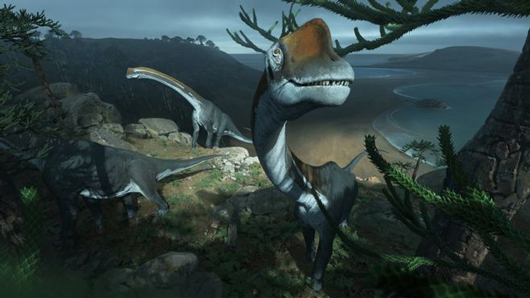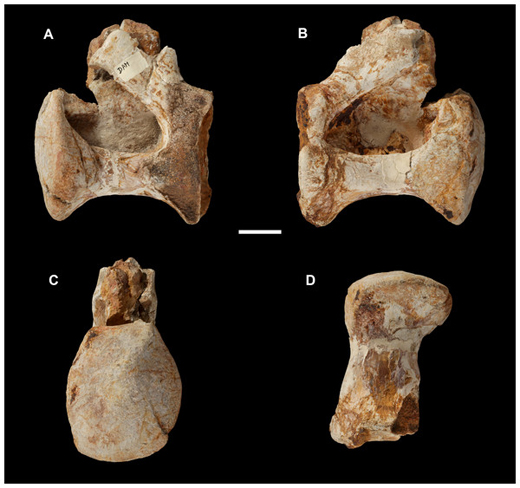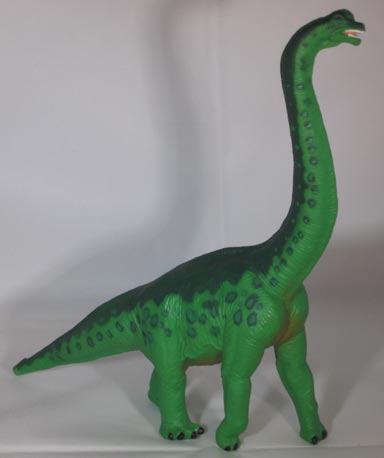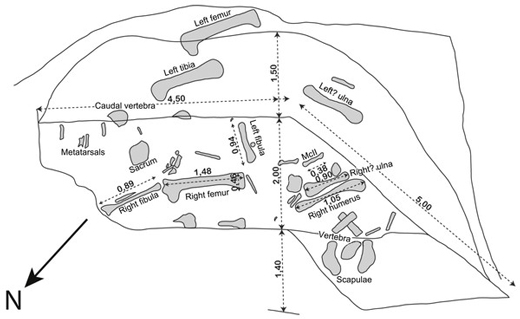Basal Brachiosaurids – Vouivria damparisensis a New Dinosaur Taxon
French Revolution for the Brachiosauridae
This week there have been a number of papers published announcing newly described dinosaurs. In time, we will get around to writing about several of them, but first, let’s take a look at the basal brachiosaurid Vouivria damparisensis, which has been described from fossil material representing a single animal that was first discovered back in 1934.
Earliest Relative of Brachiosaurus from north-eastern France
Picture credit: Imperial College London
Vouivria damparisensis
Writing in the journal “Peer J”, lead author Dr Philip Mannion (Dept. of Earth Science and Engineering at Imperial College, London) and his co-workers Ronan Allain (Natural History Museum, Paris) and Oliver Moine (Laboratory of Physical Geography, CNRS / University Paris 1 Panthéon-Sorbonne), propose that these fossils represent the earliest known brachiosaurid, a family of dinosaurs that include such well-known animals as Brachiosaurus and Giraffatitan. However, despite the high profile (no pun intended), of “arm lizard” in particular, surprisingly, very little is known about the evolution of these sauropods, Vouivria helps to fill in some significant gaps.
A Photograph of a Dorsal Vertebra from Vouivria damparisensis
Picture credit: Peer J
The picture above shows a bone from the spine of V. damparisensis. The bone comes from the front part of the dorsal vertebrae, (A) left lateral view, (B) right lateral view, (C) anterior view; (D) ventral view. Scale bar equals five centimetres.
Middle/Late Oxfordian Sauropod
The Brachiosauridae seem to have had their heyday in the Late Jurassic, Vouivria is important as relatively few sauropods are known from rocks of this age. Most Sauropod fossils from the Jurassic are associated with rocks that were laid down in the latter stages of this geological period, namely during the Kimmeridgian–Tithonian faunal stages. Vouivria damparisensis comes from strata that is several million years older, having lived around 160 – 158 million years ago. In addition, it is known from relatively complete remains.
Contrast this with the UK’s Late Jurassic sauropod fossil material, in particular the likes of Duriatitan (D. humerocristatus), which like Vouivria, has been assigned to the Titanosauriformes, the clade of long-necked dinosaurs to which the Brachiosauridae family belongs. Duriatitan is known from a single fossil bone (left femur) and this fossil, which comes from Dorset, was found in rocks that are believed to be about four million years younger than the rocks in which Vouivria was discovered.
At an estimated 15 tonnes and some 15 metres in length, Vouivria was a sizeable beast. It is likely that this dinosaur fed on the upper storeys of pine trees and Araucaria, using its long neck to reach parts of trees that other herbivorous dinosaurs could not reach.
An Illustration of a Typical Brachiosaurid
Picture credit: Everything Dinosaur
The model featured above is from the: Wild Safari Prehistoric World Models.
Revolutionising the Brachiosauridae Family Tree
The researchers were able to conduct an analysis of the Brachiosauridae family tree and an assessment of the evolutionary relationships indicates that by the Early Cretaceous, brachiosaurids were restricted to Africa and the United States. They were probably extinct in Europe.
Furthermore, the team were able to postulate that fossils that most likely represent brachiosaurids are only known from the USA, Africa and western Europe. Previously, studies examining the fossils of another long-necked dinosaur, Padillasaurus (P. leivaensis), from Lower Cretaceous rocks of Columbia, had suggested that Padillasaurus was a brachiosaurid. The detailed description of Vouivria casts doubt on this suggesting that Padillasaurus was not a member of the Brachiosauridae and that as a result brachiosaurids remain unknown from South America. Padillasaurus is placed within the Somphospondyli, another clade of Titanosauriformes, related to the brachiosaurids, but one with a much more global distribution.
A Modified Map Showing the Original Location of the Fossil Bones at the Dig Site
Picture credit: Peer J modified from Dorlodot (1934)
Building upon the original 1934 description (Dorlodot) and the subsequent reassessment of the fossil material Lapparent (1943), before the fossil material was confined to storage, the researchers have provided a valuable insight into the radiation and geographical spread of brachiosaurids. The current fossil evidence suggests that this type of sauropod spanned the Late Jurassic (Oxfordian) through to the Late Albian/Early Cenomanian of the Cretaceous. The last of the brachiosaurids lived in what is now known as the United States and it is likely that by the earliest Late Cretaceous (approximately 98 million years ago), the Brachiosauridae were extinct.
A Better Understanding of the Palaeoenvironment
The scientific paper provides a better understanding of how the remains of the dinosaur were preserved. During this period of Earth’s history, much of what we now know as western Europe consisted of a series of low-lying tropical islands. The earlier studies had concluded that as the rocks in which this dinosaur was found originally come from a coastal environment, then the corpse of Vouivria was probably washed out to sea. More detailed analysis of the surround rocks and sediments tell a different story. The researchers conclude that Vouivria died in a lagoon, a habitat that existed during a brief decline in sea levels. When sea levels rose again, the carcase was buried.
Commenting on the importance of these fossils, lead author of the study Dr Philip Mannion (Imperial College London), stated:
“We don’t know what this creature died from, but millions of years later it is providing important evidence to help us understand in more detail the evolution of brachiosaurid sauropods and a much bigger group of dinosaurs that they belonged to, called Titanosauriformes.”
Visit the award-winning Everything Dinosaur website: Everything Dinosaur.





